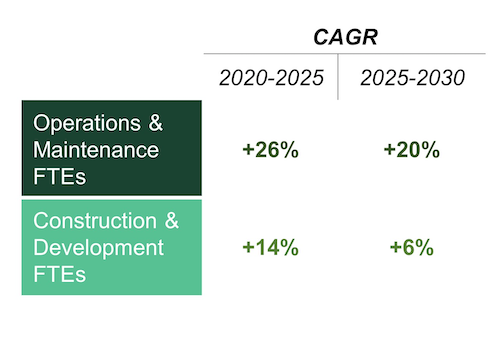Demand for offshore wind staff will triple by the end of the decade, surging to 868,000 full-time jobs from an estimated 297,000 in 2020. The hiring spree will already be visible in the middle of the decade as job demand could reach about 589,000 in 2025, according to a recent analysis from Rystad Energy, an independent energy research and business intelligence company.
Operation and maintenance (O&M) jobs, driven by the installed capacity of wind farms, contributed about 7% of the total job count in 2020 and will make up about 12% in 2025. With a rapid increase in offshore wind installed capacity, O&M will gain a larger share of the total jobs. Construction and development (C&D) roles related to manufacturing – turbines, cables, substations and foundations – contribute about 66% of the total potential, while installation jobs account for 10% and project development for 4%. O&M adds a 20% share to the total jobs potential.
By 2030, turbine manufacturing will continue to create most of the jobs, accounting for 54% of the total. Turbine manufacturers such as Siemens Gamesa, Vestas, Goldwind and GE Renewable Energy are expected to employ additional labor and establish more factories for bigger turbines in the coming years.
Rystad Energy estimates that Europe, Asia outside of China and the Americas will drive the global jobs creation in the offshore wind sector. Europe, which dominates the offshore wind installed capacity globally, could expect to see demand for jobs more than triple by 2030, from 110,000 jobs in 2020 to around 350,000.
In the Americas, the U.S. will be a major driver for offshore wind deployment because of the ambitious plans to decarbonize the power sector by 50% by 2030 put forward by the current administration. Rystad estimates that the U.S. will have almost 15 GW of offshore wind installed capacity by 2030, with 30% coming from recent solicitations held by New York.
“Oil and gas workers will also benefit from this expected growth in offshore wind employment globally, as they share some skillsets and essential offshore knowledge,” says Alexander Fløtre, product manager for offshore wind at Rystad Energy. “Offshore wind areas such as foundation manufacturing, offshore construction, project development and O&M have been highly relevant to oil and gas operations.“
Offshore oil and gas and offshore wind operations have similar safety standards, with workers requiring at least basic offshore emergency training and often helicopter underwater escape training before deploying to offshore projects. This could be a great opportunity to recover some of the talent lost during the oil and gas industry downturn, especially O&M, project development and engineering jobs.




